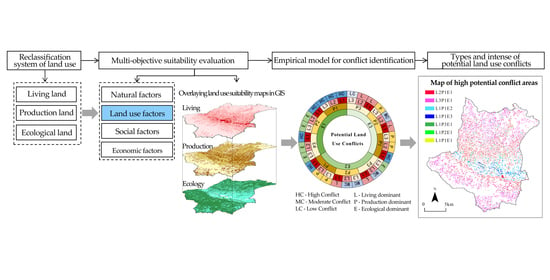Potential Land Use Conflict Identification Based on Improved Multi-Objective Suitability Evaluation
Abstract
:1. Introduction
2. Materials and Methods
2.1. Research Area
2.2. Data Sources and Processing
2.3. Research Framework
2.4. Research Methods
2.4.1. Classification System of Land Use Functions
2.4.2. Construction of Multi-Objective Suitability Evaluation Model
2.4.3. Identification of Potential Land Use Conflicts
3. Results and Analysis
3.1. Single-Factor Spatial Analysis
3.2. Land Use Suitability Analysis
3.3. Diagnosis of Potential Land Use Conflict
4. Discussion
5. Conclusions
Author Contributions
Funding
Institutional Review Board Statement
Informed Consent Statement
Data Availability Statement
Conflicts of Interest
References
- Long, H.; Li, X. Cultivated-land Transition and Land Consolidation and Reclamation in China: Research progress and frame. Prog. Geogr. 2006, 25, 67–76. [Google Scholar]
- Ran, N.; Jin, X.; Fan, Y.; Xiang, X. Three lines’ delineation based on land use conflict identification and coordination in Jintan District, Changzhou. Resour. Sci. 2018, 40, 284–298. [Google Scholar]
- Bohua, Y.; Changhe, L. The progress and prospect of land use conflicts. Prog. Geogr. 2006, 25, 106–115. [Google Scholar]
- Campbell, D.J.; Gichohi, H.; Mwangi, A.; Chege, L. Land use conflict in Kajiado district, Kenya. Land Use Policy 2000, 17, 337–348. [Google Scholar] [CrossRef]
- Lian, H.; Lejano, R.P. Interpreting institutional fit: Urbanization, development, and China’s “land-lost”. World Dev. 2014, 61, 1–10. [Google Scholar] [CrossRef]
- Wei, Y.D.; Ye, X. Urbanization, Land Use, and Sustainable Development in China; Springer: Berlin/Heidelberg, Germany, 2014. [Google Scholar]
- Pan, J. From industrial toward ecological in China. Science 2012, 336, 1397. [Google Scholar] [CrossRef] [PubMed] [Green Version]
- Ye, L.; Wu, A.M. Urbanization, land development, and land financing: Evidence from Chinese cities. J. Urban Aff. 2014, 36, 354–368. [Google Scholar] [CrossRef]
- Zhou, D.; Xu, J.; Lin, Z. Conflict or coordination? Assessing land use multi-functionalization using production-living-ecology analysis. Sci. Total. Environ. 2017, 577, 136–147. [Google Scholar] [CrossRef]
- Mu, D.; Luo, P.; Lyu, J.; Zhou, M.; Huo, A.; Duan, W.; Nover, D.; He, B.; Zhao, X. Impact of temporal rainfall patterns on flash floods in Hue City, Vietnam. J. Flood Risk Manag. 2021, 14, e12668. [Google Scholar] [CrossRef]
- Luo, P.; Kang, S.; Zhou, M.; Lyu, J.; Aisyah, S.; Binaya, M.; Regmi, R.K.; Nover, D. Water quality trend assessment in Jakarta: A rapidly growing Asian megacity. PLoS ONE 2019, 14, e0219009. [Google Scholar] [CrossRef] [Green Version]
- Berry, D.; Plaut, T. Retaining agricultural activities under urban pressures: A review of land use conflicts and policies. Policy Sci. 1978, 9, 153–178. [Google Scholar] [CrossRef]
- Zou, L.; Liu, Y.; Wang, J.; Yang, Y.; Wang, Y. Land use conflict identification and sustainable development scenario simulation on China’s southeast coast. J. Clean. Prod. 2019, 238, 117899. [Google Scholar] [CrossRef]
- Ishiyama, N. Environmental justice and American Indian tribal sovereignty: Case study of a land–use conflict in Skull Valley, Utah. Antipode 2003, 35, 119–139. [Google Scholar] [CrossRef]
- Coyle, D.J. This land is your land, this land is my land: Cultural conflict in environmental and land-use regulation. In Politics, Policy, and Culture; Routledge: Milton Park, UK, 2019; pp. 33–50. [Google Scholar]
- Ayhan, Ç.K.; Taşlı, T.C.; Özkök, F.; Tatl, H. Land use suitability analysis of rural tourism activities: Yenice, Turkey. Tour. Manag. 2020, 76, 103949. [Google Scholar] [CrossRef]
- Willemen, L.; Hein, L.; van Mensvoort, M.E.; Verburg, P.H. Space for people, plants, and livestock? Quantifying interactions among multiple landscape functions in a Dutch rural region. Ecol. Indic. 2010, 10, 62–73. [Google Scholar] [CrossRef]
- Guo, B.; Wang, X.; Pei, L.; Su, Y.; Zhang, D.; Wang, Y. Identifying the spatiotemporal dynamic of PM2.5 concentrations at multiple scales using geographically and temporally weighted regression model across China during 2015–2018. Sci. Total. Environ. 2021, 751, 141765. [Google Scholar] [CrossRef] [PubMed]
- Guterbock, T.M. Sociology and the land-use problem. Urban Aff. Q. 1980, 15, 243–267. [Google Scholar] [CrossRef]
- Zhou, D.; Xu, J.; Wang, L. Research progress and Prospect of land use conflict in China in recent 15 years. China Land Sci. 2015, 29, 21–29. (In Chinese) [Google Scholar]
- Hersperger, A.M.; Ioja, C.; Steiner, F.; Tudor, C.A. Comprehensive consideration of conflicts in the land-use planning process: A conceptual contribution. Carpathian J. Earth Environ. Sci. 2015, 10, 5–13. [Google Scholar]
- Reuber, P. Conflict studies and critical geopolitics—theoretical concepts and recent research in political geography. GeoJournal 2000, 50, 37–43. [Google Scholar] [CrossRef]
- Nash, N.; Lewis, A.; Griffin, C. Not in our front garden: Land use conflict, spatial meaning and the politics of naming place. J. Community Appl. Soc. Psychol. 2010, 20, 44–56. [Google Scholar] [CrossRef]
- Kim, I.; Arnhold, S. Mapping environmental land use conflict potentials and ecosystem services in agricultural watersheds. Sci. Total. Environ. 2018, 630, 827–838. [Google Scholar] [CrossRef] [PubMed]
- Zhang, Y.; Li, A.; Fung, T. Using GIS and multi-criteria decision analysis for conflict resolution in land use planning. Procedia Environ. Sci. 2012, 13, 2264–2273. [Google Scholar] [CrossRef] [Green Version]
- Brown, G.; Raymond, C.M. Methods for identifying land use conflict potential using participatory mapping. Landsc. Urban Plan. 2014, 122, 196–208. [Google Scholar] [CrossRef]
- Gong, J.; Liu, Y.; Chen, W. Land suitability evaluation for development using a matter-element model: A case study in Zengcheng, Guangzhou, China. Land Use Policy 2012, 29, 464–472. [Google Scholar] [CrossRef]
- Jensen, D.; Baird, T.; Blank, G. New landscapes of conflict: Land-use competition at the urban–rural fringe. Landsc. Res. 2019, 44, 418–429. [Google Scholar] [CrossRef]
- Yusran, Y.; Sahide, M.A.K.; Supratman, S.; Sabar, A.; Krott, M.; Giessen, L. The empirical visibility of land use conflicts: From latent to manifest conflict through law enforcement in a national park in Indonesia. Land Use Policy 2017, 62, 302–315. [Google Scholar] [CrossRef]
- Mann, C.; Jeanneaux, P. Two approaches for understanding land-use conflict to improve rural planning and management. J. Rural. Community Dev. 2009, 4(1), 118–141. [Google Scholar]
- Peng, J.; Zhao, M.; Guo, X.; Pan, Y.; Liu, Y. Spatial-temporal dynamics and associated driving forces of urban ecological land: A case study in Shenzhen City, China. Habitat Int. 2017, 60, 81–90. [Google Scholar] [CrossRef]
- Magsi, H.; Torre, A.; Liu, Y.; Sheikh, M.J. Land use conflicts in the developing countries: Proximate driving forces and preventive measures. Pak. Dev. Rev. 2017, 56, 19–30. [Google Scholar] [CrossRef] [Green Version]
- Bohua, L.; Can, Z.; Yindi, D. Change of human settlement environment and driving mechanism in traditional villages based on living-production-ecological space: A case study of lanxi village, Jiangyong County, Hunan Province. Prog. Geogr. 2018, 37, 677–687. (In Chinese) [Google Scholar]
- Zhang, J. Reducing Land-Use Conflict: Impacts of Leasing Arrangements on Livestock and Rangelands in Laikipia, Kenya. Senior Thesis, Princeton University, Princeton, NJ, USA, 2019. [Google Scholar]
- Petrescu-Mag, R.M.; Petrescu, D.C.; Azadi, H.; Petrescu-Mag, I.V. Agricultural land use conflict management—Vulnerabilities, law restrictions and negotiation frames. A wake-up call. Land Use Policy 2018, 76, 600–610. [Google Scholar] [CrossRef]
- Barnaud, C.; Le Page, C.; Dumrongrojwatthana, P.; Trébuil, G. Spatial representations are not neutral: Lessons from a participatory agent-based modelling process in a land-use conflict. Environ. Model. Softw. 2013, 45, 150–159. [Google Scholar] [CrossRef]
- Evans, J.D.; Kirkpatrick, J.B.; Bridle, K.L. A reciprocal triangulation process for identifying and mapping potential land use conflict. Environ. Manag. 2018, 62, 777–791. [Google Scholar] [CrossRef]
- Yongfang, Y.; Qian, A.; Lianqi, Z. Diagnosis based on the PSR model of rural land-use conflicts intensity. Prog. Geogr. 2012, 31, 1552–1560. [Google Scholar]
- Zhao, J.; Luo, Z.; Zhao, Y.; Gao, L.; Ran, F.; Jiang, C. Diagnosis of the intensity of regional land use conflict based on improved grey target model: A case of Nanchang City. Acta Agric. Univ. Jiangxiensis 2017, 39, 1256–1263. [Google Scholar]
- Lihong, L.; Wenyuan, D.; Juan, C. Spatial conflict between ecological-production-living spaces on Pingtan Island during rapid urbanization. Resour. Sci. 2017, 39, 1823. [Google Scholar]
- Ye, Q.; Wei, R.; Zhang, P. A conflict identification method of Urban, agricultural and ecological spaces based on the space conversion matrix. Sustainability 2018, 10, 3502. [Google Scholar] [CrossRef] [Green Version]
- Min, J.; Wang, Y.; Bai, R.; Zhang, J.; Kong, X. The research on identification of land use potential conflict based on multiobjective suitability evaluation on mountainous city: A case study of Qijiang district of Chongqing municipality. J. Chongqing Norm. Univ. (Nat. Sci.) 2018, 35, 83–89. [Google Scholar]
- Wei, C.; Xuelu, L. The research on identification of potential land use conflict based on suitability evaluation—A case study on Honghe County of Yunnan Province. J. Gansu Agric. Univ. 2015, 50, 123. [Google Scholar]
- Qiaoqin, L.; Huafu, Z.; Kening, W. Identifying potential land use conflict based on competitiveness of different land use types in Beijing. China 2014, 36, 1579–1589. [Google Scholar]
- Santé-Riveira, I.; Crecente-Maseda, R.; Miranda-Barrós, D. GIS-based planning support system for rural land-use allocation. Comput. Electron. Agric. 2008, 63, 257–273. [Google Scholar] [CrossRef]
- Luo, P.; Mu, D.; Xue, H.; Ngo-Duc, T.; Dang-Dinh, K.; Takara, K.; Nover, D.; Schladow, G. Flood inundation assessment for the Hanoi Central Area, Vietnam under historical and extreme rainfall conditions. Sci. Rep. 2018, 8, 1–11. [Google Scholar] [CrossRef] [PubMed]
- Liu, Y.-S.; Wang, J.-Y.; Guo, L.-Y. GIS-based assessment of land suitability for optimal allocation in the Qinling Mountains, China. Pedosphere 2006, 16, 579–586. [Google Scholar] [CrossRef]
- Reshmidevi, T.; Eldho, T.; Jana, R. A GIS-integrated fuzzy rule-based inference system for land suitability evaluation in agricultural watersheds. Agric. Syst. 2009, 101, 101–109. [Google Scholar] [CrossRef]
- Akıncı, H.; Özalp, A.Y.; Turgut, B. Agricultural land use suitability analysis using GIS and AHP technique. Comput. Electron. Agric. 2013, 97, 71–82. [Google Scholar] [CrossRef]
- Fontes, M.P.; Fontes, R.M.; Carneiro, P.A. Land suitability, water balance and agricultural technology as a Geographic-Technological Index to support regional planning and economic studies. Land Use Policy 2009, 26, 589–598. [Google Scholar] [CrossRef]
- Huang, A.; Xu, Y.; Lu, L.; Liu, C.; Zhang, Y.; Hao, J.; Wang, H. Research progress of the identification and optimization of production-living-ecological spaces. Prog. Geogr. 2020, 39, 503–518. [Google Scholar] [CrossRef]
- Odum, E.P. The strategy of ecosystem development. In The Ecological Design and Planning Reader; Springer: Berlin/Heidelberg, Germany, 2014; pp. 203–216. [Google Scholar]
- Carr, M.H.; Zwick, P.D. Smart Land-Use Analysis: The LUCIS Model Land-Use Conflict Identification Strategy; ESRI, Inc.: Redlands, CA, USA, 2007. [Google Scholar]
- Liu, Y. Introduction to land use and rural sustainability in China. Land Use Policy 2018, 74, 1–4. [Google Scholar] [CrossRef]
- Jilai, L.; Yansui, L.; Yurui, L. Classification evaluation and spatial-temporal analysis of “production-living-ecological”spaces in China. J. Geogr. Sci. 2017, 72, 1290–1304. (In Chinese) [Google Scholar]
- Wantai, H.; Liguo, W.; Muhui, S. Reflections on delimiting the three basic spaces in the complication of urban and rural plans. Urban Plan. 2016, 40, 21–26. (In Chinese) [Google Scholar]
- Jinchuan, H.; Haoxi, L.; Xiaoxiao, Q. A literature review on optimization of spatial development pattern based on ecological-production-living space. Prog. Geogr. 2017, 36, 378–391. [Google Scholar]
- Tu, S.; Long, H.; Zhang, Y.; Ge, D.; Qu, Y. Rural restructuring at village level under rapid urbanization in metropolitan suburbs of China and its implications for innovations in land use policy. Habitat Int. 2018, 77, 143–152. [Google Scholar] [CrossRef]
- Iojă, C.I.; Niţă, M.R.; Vânău, G.O.; Onose, D.A.; Gavrilidis, A.A. Using multi-criteria analysis for the identification of spatial land-use conflicts in the Bucharest Metropolitan Area. Ecol. Indic. 2014, 42, 112–121. [Google Scholar] [CrossRef]
- Romano, G.; Dal Sasso, P.; Liuzzi, G.T.; Gentile, F. Multi-criteria decision analysis for land suitability mapping in a rural area of Southern Italy. Land Use Policy 2015, 48, 131–143. [Google Scholar] [CrossRef]
- Zhu, Y.; Luo, P.; Zhang, S.; Sun, B. Spatiotemporal analysis of hydrological variations and their impacts on vegetation in semiarid areas from multiple satellite data. Remote Sens. 2020, 12, 4177. [Google Scholar] [CrossRef]
- Shukui, T. Discussion on classification scheme of land conflict in China. Chin. J. Agric. Resour. Reg. Plan. 2008, 4, 27–30. [Google Scholar]
- Bin, P.; Tao, P. Land use system dynamic modeling: Literature review and future research direction in China. Prog. Geogr. 2010, 29, 1060–1066. [Google Scholar]
- Zhang, Y.; Luo, P.; Zhao, S.; Kang, S.; Wang, P.; Zhou, M.; Lyu, J. Control and remediation methods for eutrophic lakes in the past 30 years. Water Sci. Technol. 2020, 81, 1099–1113. [Google Scholar] [CrossRef] [PubMed]
- da Silva Neves, S.M.A.; Nunes, M.C.M.; Neves, R.J.; Kreitlow, J.P.; dos Santos Galvanin, E.A. Susceptibility of soil to hydric erosion and use conflicts in the microregion of Tangará da Serra, Mato Grosso, Brazil. Environ. Earth Sci. 2015, 74, 813–827. [Google Scholar] [CrossRef]
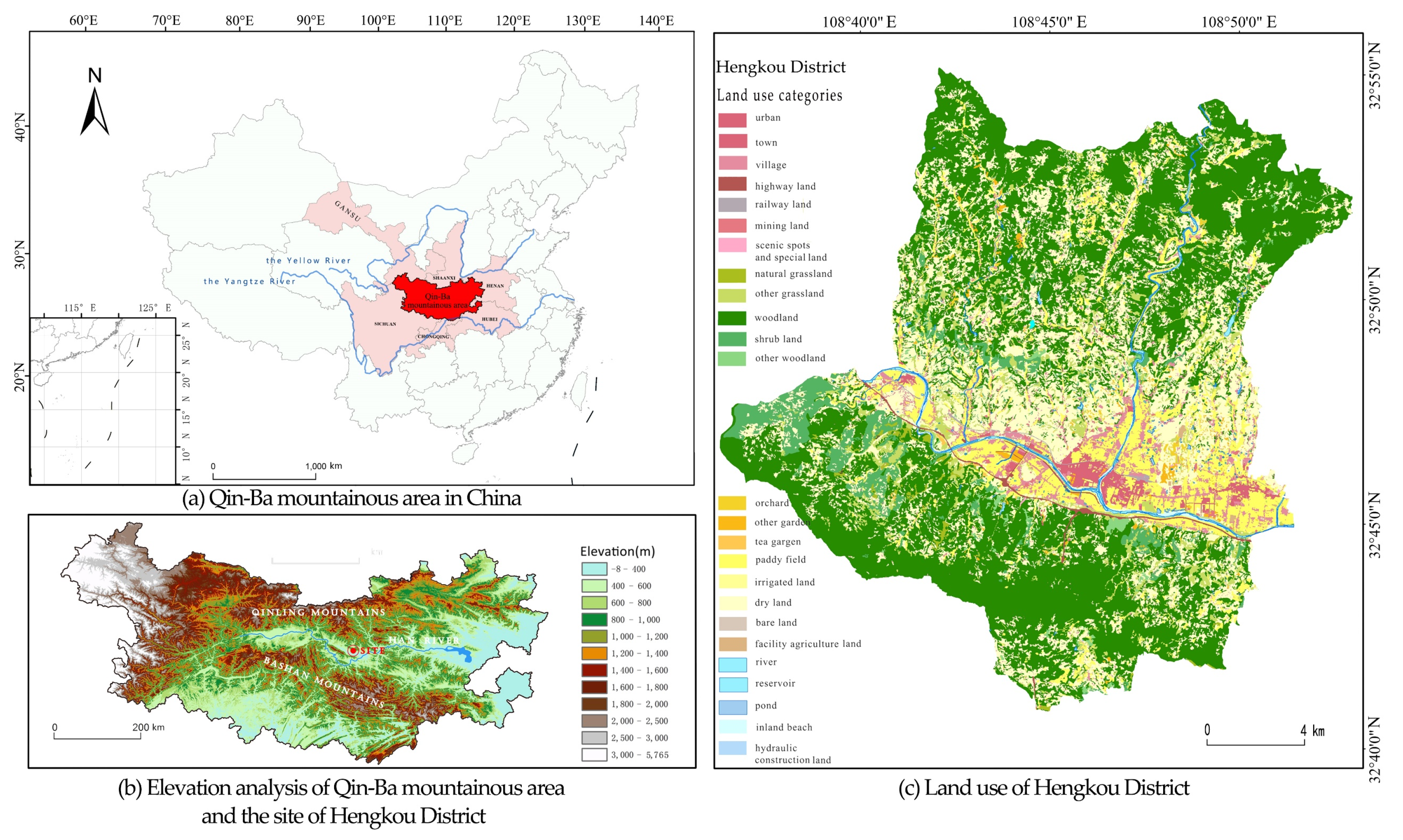

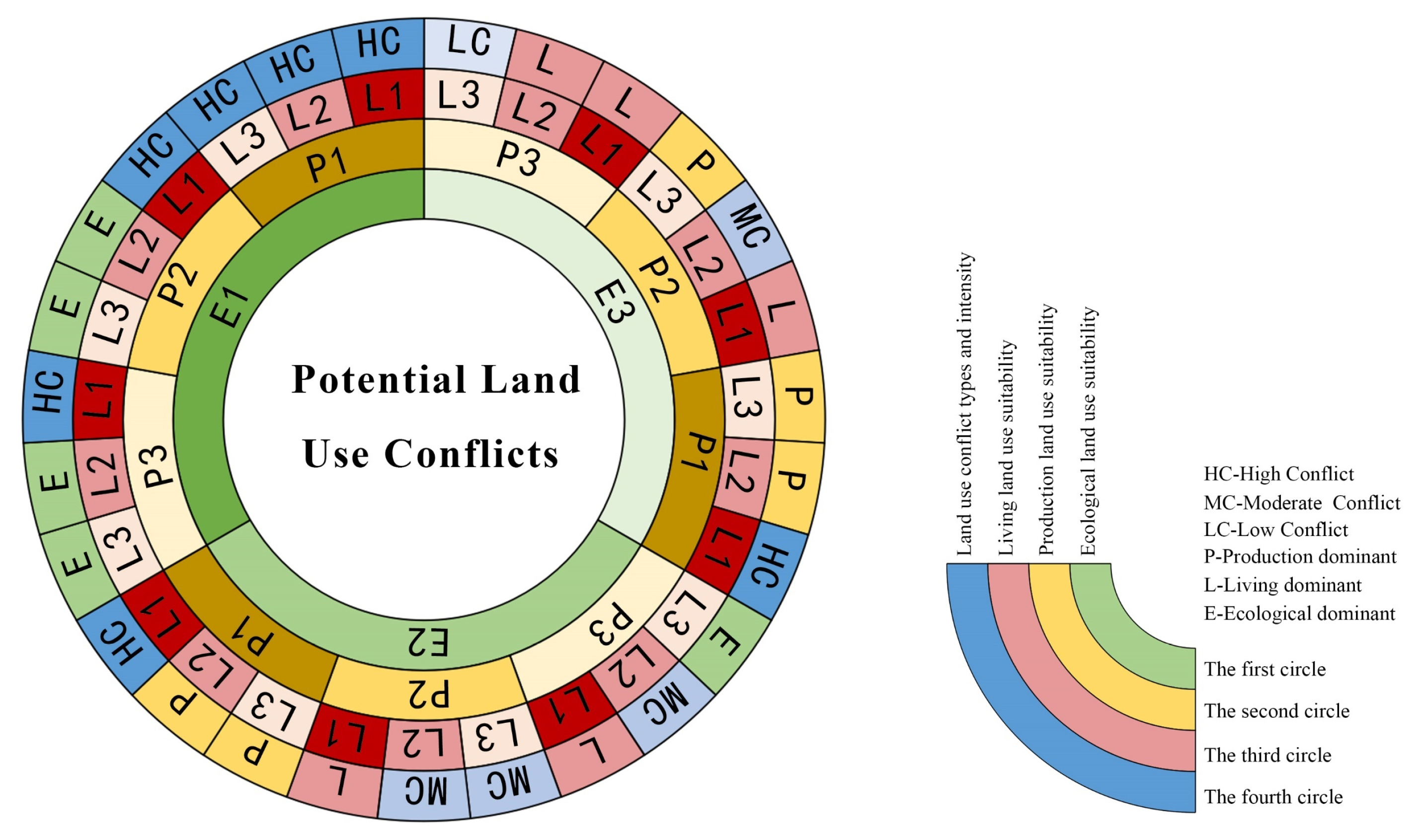


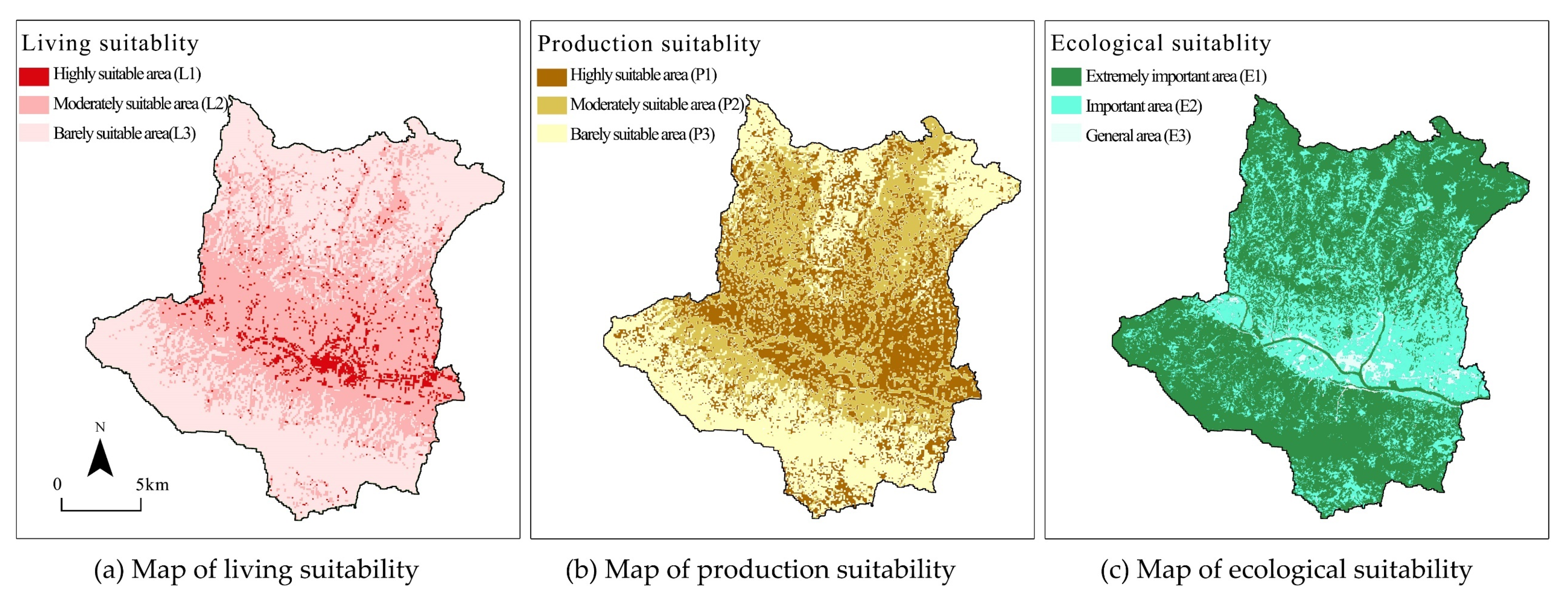
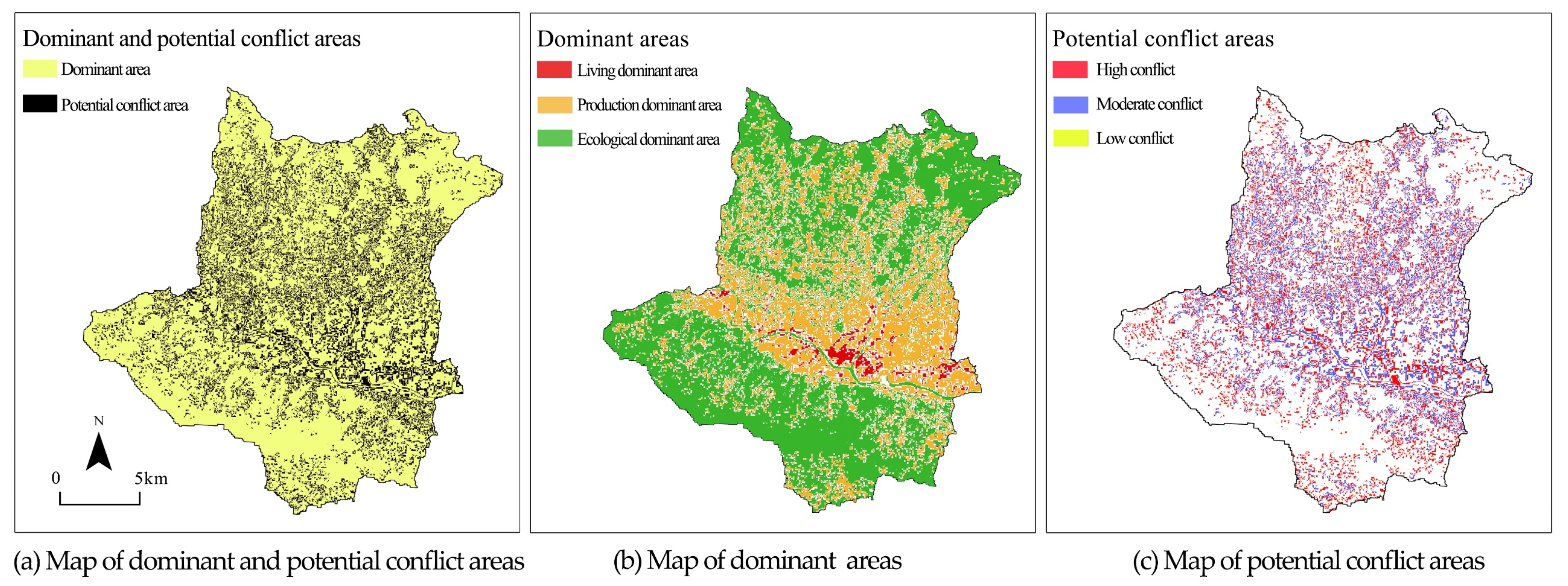
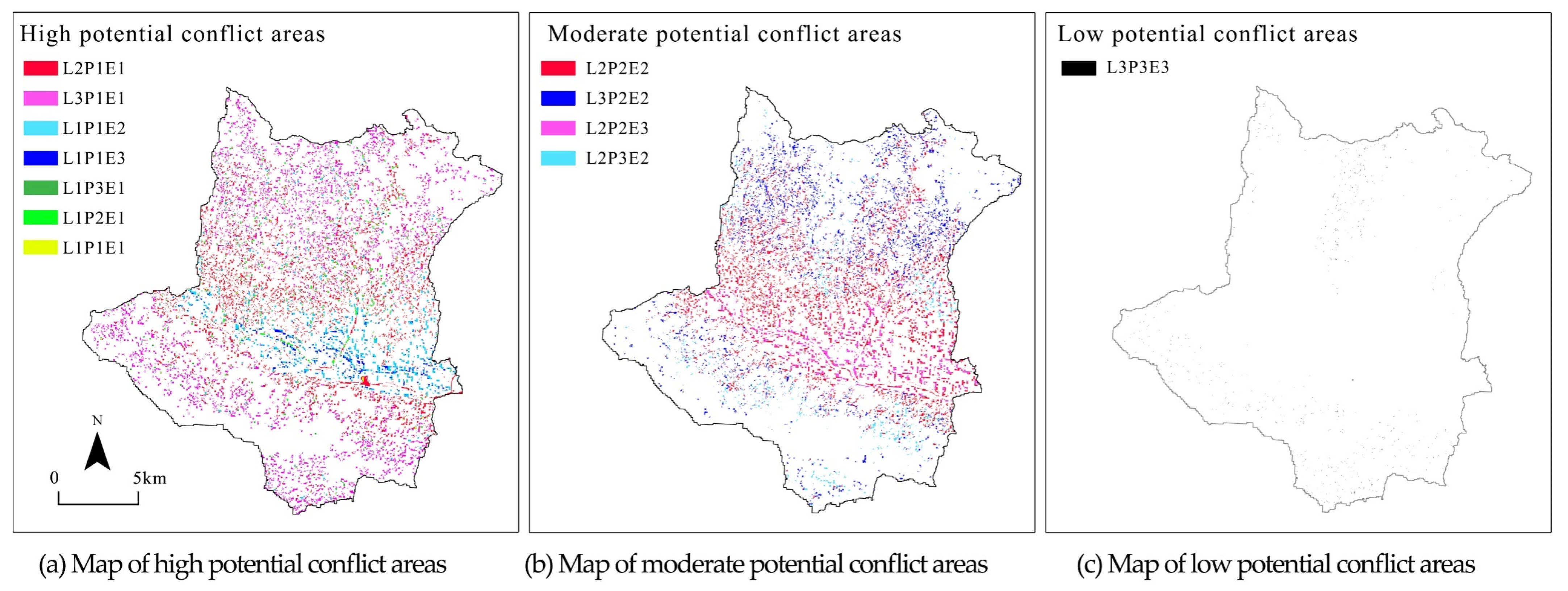
| Land Management Law | Current Land Use Classification (GB/T21010–2007) | Classification of Living-Production-Ecology | Differences | |||
|---|---|---|---|---|---|---|
| First-Class | Second-Class | Living | Production | Ecology | ||
| Agricultural land | Cropland | - | L-d | P-b | E-b | Emphasizing the ecological function of agricultural land |
| Garden | - | L-d | P-b | E-b | ||
| Grassland | Natural grassland | L-d | P-c | E-a | ||
| Artificial grassland | L-d | P-c | E-c | |||
| Other | Facility agricultural land | L-d | P-b | E-c | ||
| Ridge | L-d | P-b | E-b | |||
| Water and conservancy facilities land | Pond | L-d | P-c | E-c | ||
| Ditch | L-d | P-b | E-c | |||
| Construction land | Reservoir | L-d | P-c | E-c | Emphasizing the production function of construction land | |
| Land for public management and service facilities | Land for scenic spots and facilities | L-b | P-b | E-d | ||
| Park and green land | L-b | P-d | E-c | Emphasizing the ecological function of urban construction land | ||
| Principal | Weight | Index | Weight | Grading and Assignment | ||||
|---|---|---|---|---|---|---|---|---|
| 1 | 3 | 5 | 7 | 9 | ||||
| Natural conditions | 0.4133 | Slope | 0.6370 | >35 | 25–35 | 15–25 | 8–15 | <8 |
| Altitude/m | 0.2853 | <400 | 400–600 | 600–800 | 800–1000 | >1000 | ||
| Distance from river/m | 0.1047 | >2000 | 1500–2000 | 1000–1500 | 500–1000 | <500 | ||
| Land management | 0.1076 | Construction land expansion boundary | 0.6667 | - | outside | - | inside | - |
| Distance from natural disasters (m) | 0.3333 | <1500 | 1500–2500 | 2500–3500 | 3500–5500 | >5500 | ||
| Current land use | 0.2922 | - | 1.0000 | L-d | L-c | L-b | - | L-a |
| Public services | 0.1867 | Population density | 0.5396 | 0.007–0.110 | 0.110–0.190 | 0.190–0.276 | 0.276–0.428 | 0.428–0.865 |
| Distance from main roads (m) | 0.2382 | <100 | 100–500 | 500–1000 | 1000–1500 | >1500 | ||
| Distance from main service facilities (m) | 0.1416 | <1000 | 1000–2000 | 2000–3000 | 3000–4000 | >4000 | ||
| Distance from the urban | 0.1634 | 0.008–0.110 | 0.110–0.190 | 0.190–0.276 | 0.276–0.428 | 0.428–0.865 | ||
| Principal | Weight | Index | Weight | Grading and Assignment | ||||
|---|---|---|---|---|---|---|---|---|
| 1 | 3 | 5 | 7 | 9 | ||||
| Natural conditions | 0.3369 | Slope | 0.3028 | >35 | 25–35 | 15–25 | 8–15 | <8 |
| Altitude (m) | 0.0809 | <400 | 400–600 | 600–800 | 800–1000 | >1000 | ||
| Slope aspect | 0.0865 | - | shady | half shady | half sunny | sunny | ||
| Distance from rivers (m) | 0.3045 | >2000 | 1500–2000 | 1000–1500 | 500–1000 | <500 | ||
| Physical clay content of soil (%) | 0.2254 | - | 15 (sandy loam) | - | 26/28/29 (light loam) | 31 (medium loam) | ||
| Land management | 0.1416 | Basic farmland protection line | 0.6667 | - | outside | - | inside | - |
| Distance from natural disasters (m) | 0.3333 | <1500 | 1500–2500 | 2500–3500 | 3500–5500 | >5500 | ||
| Current land use | 0.2382 | - | - | P-d | P-c | - | P-b | P-a |
| Utilization level | 0.2833 | Grain yield (tons/ha) | 0.5396 | 0.007–0.110 | 0.110–0.190 | 0.190–0.276 | 0.276–0.428 | 0.428–0.865 |
| Cultivated land (mu/per) | 0.1634 | 0.008–0.110 | 0.110–0.190 | 0.190–0.276 | 0.276–0.428 | 0.428–0.865 | ||
| Per-capita net income (Yuan/Per) | 0.2970 | <6850 | 6850–9120 | 9120–10,850 | 10,850–12,230 | >12,230 | ||
| Principal | Weight | Index | Weight | Grading and Assignment | ||||
|---|---|---|---|---|---|---|---|---|
| 1 | 3 | 5 | 7 | 9 | ||||
| Natural environment | 0.400 | Slope | 0.1921 | <8 | 8–15 | 15–25 | 25–35 | >35 |
| Altitude/m | 0.0626 | <400 | 400–600 | 600–800 | 800–1000 | >1000 | ||
| NDVI | 0.4304 | 0.226–0.412 | 0.163–0.226 | 0.116–0.163 | 0.065–0.116 | −0.087–0.065 | ||
| Distance from rivers/m | 0.3147 | >2000 | 1500–2000 | 1000–1500 | 500–1000 | <500 | ||
| Land management | 0.200 | Ecological land Protection line | 0.6667 | - | outside | - | inside | - |
| Distance from natural disasters/m | 0.3333 | >5500 | 3500–5500 | 2500–3500 | 1500–2500 | <1500 | ||
| Current land use | 0.400 | - | - | E-d | E-c | E-b | - | E-a |
| Suitability Classification | Living Suitability | Production Suitability | Ecological Suitability | ||||||
|---|---|---|---|---|---|---|---|---|---|
| L1 | L2 | L3 | P1 | P2 | P3 | E1 | E2 | E3 | |
| Score range | 6.5–9.0 | 3.5–6.5 | 0.6–3.5 | 0.7–2.6 | 2.6–4.9 | 4.9–8.9 | 6.0–9.0 | 2.4–6.0 | 0.3–2.4 |
| Area (km2) | 19.78 | 156.86 | 195.72 | 113.92 | 122.65 | 135.79 | 215.01 | 135.01 | 22.34 |
| Percent (%) | 5.31 | 42.13 | 52.56 | 30.59 | 32.94 | 36.47 | 57.75 | 36.25 | 6.00 |
| Intensity | High | Moderate | Low | ||||||
|---|---|---|---|---|---|---|---|---|---|
| Type | L2P1E1 L3P1E1 | L1P1E2 L1P1E3 | L1P2E1 L1P3E1 | L1P1E1 | L2P2E2 | L3P2E2 | L2P2E3 | L2P3E2 | L3P3E3 |
| Area (km2) | 33.56 | 8.91 | 1.99 | 0.92 | 18.21 | 9.45 | 6.17 | 2.23 | 0.59 |
| Sum (km2) | 45.38 | 36.06 | 0.59 | ||||||
| Percent (%) | 55.32 | 43.95 | 0.73 | ||||||
Publisher’s Note: MDPI stays neutral with regard to jurisdictional claims in published maps and institutional affiliations. |
© 2021 by the authors. Licensee MDPI, Basel, Switzerland. This article is an open access article distributed under the terms and conditions of the Creative Commons Attribution (CC BY) license (https://creativecommons.org/licenses/by/4.0/).
Share and Cite
Jing, W.; Yu, K.; Wu, L.; Luo, P. Potential Land Use Conflict Identification Based on Improved Multi-Objective Suitability Evaluation. Remote Sens. 2021, 13, 2416. https://doi.org/10.3390/rs13122416
Jing W, Yu K, Wu L, Luo P. Potential Land Use Conflict Identification Based on Improved Multi-Objective Suitability Evaluation. Remote Sensing. 2021; 13(12):2416. https://doi.org/10.3390/rs13122416
Chicago/Turabian StyleJing, Wenli, Kanhua Yu, Lian Wu, and Pingping Luo. 2021. "Potential Land Use Conflict Identification Based on Improved Multi-Objective Suitability Evaluation" Remote Sensing 13, no. 12: 2416. https://doi.org/10.3390/rs13122416
APA StyleJing, W., Yu, K., Wu, L., & Luo, P. (2021). Potential Land Use Conflict Identification Based on Improved Multi-Objective Suitability Evaluation. Remote Sensing, 13(12), 2416. https://doi.org/10.3390/rs13122416





